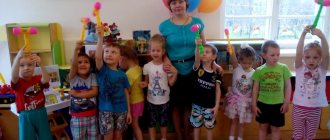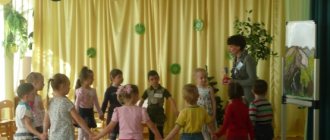Progress of the game
The teacher calls the children:
I'll sit next to you on the bench,
I'll sit with you.
I'll tell you riddles
I'll see who's smarter.
The teacher, together with the first subgroup of children, sits on the modules and looks at illustrations for riddles without words. Children choose pictures that they can make a wish without saying a word. The second subgroup at this time is located in another part of the hall.
Children of the first subgroup, without words , using facial expressions and gestures, depict, for example: the wind, the sea, a stream, a teapot (if it’s difficult, then: a cat, a barking dog, a mouse, etc.)
.
Children of the second subgroup guess . subgroup guesses , and the first guesses.
"ANIMALS"
Goal: To develop onomatopoeia skills in children.
Progress of the game.
Using a rhyme, a child is selected to play the role of king. The remaining child workers are divided into several groups (3 - 4)
and agree on what they will do and what work they will be hired for.
Then they approach the king in groups .
Workers. Hello King!
King. Hello!
Workers. Do you need workers?
King. What can you do?
Workers: Guess it!
Children, acting with imaginary objects, demonstrate various professions: cooking, washing clothes, sewing clothes, embroidering, watering plants, etc. The king must guess the profession of the workers. If he does it correctly, he will catch up with the fleeing children. The first child caught becomes king. Over time, the game can be complicated by introducing new characters (queen, minister, princess, etc.), as well as inventing the characters of the characters (king - greedy, cheerful, evil; queen - kind, grumpy, frivolous).
"GRANDMOTHER MALANYA"
Goal: To develop attention, imagination, resourcefulness, the ability to create images using facial expressions, gestures, and plasticity.
Progress of the game.
Children hold hands and walk in a circle, in the center of which is the driver; children sing a nursery rhyme and perform movements.
At Malanya's, at the old woman's, (They walk in a circle and sing.)
Lived in a small hut
Seven daughters
Seven sons
All without eyebrows! (They stop and, using facial expressions and gestures, depict what is said in the text.)
With eyes like these
With ears like that -
With such noses
With such a mustache
With such a head
With such a beard.
We didn’t eat anything (They squat down and prop their chin with one hand.)
—
We sat all day.
On him (her)
looked
They did it like this. (Repeat any gesture after the leader.)
GAME – PANTOMIME “THE BEAR CUB”
Goal: develop pantomime skills
Project “Project of musical and theatrical activities “The Magic World of Theater” in senior group No. 2”
LIST OF DIDACTIC MATERIALS (LITERATURE) FOR SOLVING THE TASKS AND GOALS OF THE PROJECT
1. “Musical palette” No. 6 2005
2. “Musical Director” No. 6, 7, 8 2008; No. 1 2009
3. S. I. Merzlyakova “The Magic World of Theater” (for children 5-7 years old).
4. A. I. Burenina “Rhythmic mosaic”.
5. N. A. Sorokina “Theatre, creativity, children”
6. “Puppet theater for preschoolers” T. N. Karamanenko, Yu. G. Karamanenko
CONSULTATION FOR TEACHERS
THEATER GAMES
THE PATH TO CHILDREN'S CREATIVITY.
A developing environment that promotes self-expression in the process of artistic activity is of great importance for the development of a child’s personality.
A person who is equally developed both emotionally and intellectually can be called truly integral. We must strive to develop both in a child. Unfortunately, most often, emotional education is neglected, giving preference to the development of intellectual capabilities.
“The danger is not that machines will start thinking. Like a person, but the fact is that a person will begin to think like a machine!” – Professor G. Suvorov.
“Harmony of mind and heart is the ultimate goal of educating a modern person” - D. B. Kabalevsky.
A child who gets used to expressing his emotions through various types of artistic activities begins to view his “I” in a new way, his own behavior and the behavior of others, his relationships with people, as well as nature and the world around him. Raising a whole personality is not an easy task. This requires conditions: the presence of a teacher and the presence of an environment that evokes a positive emotional response from the child. Hence the need arises for forms of classes in which each child will actively experience the content of the lesson and actively participate in artistic self-expression. A preschooler should not just sit in class and obediently complete tasks. The joy of creativity, an active relationship with an adult, takes the child from a position of passive acquisition of knowledge, skills and abilities to a position of creative activity, initiative, and independence. Only this can develop creativity in every child.
With all the variety of types of artistic activity, theatrical games occupy a special place in the educational process. They are designed for children's activity, for their creative interaction with each other, for artistic and active communication with adults. Through theatrical play, the child receives information about the world around him, and his creative abilities are formed. With the help of such expressive means as intonation, facial expressions, gestures, gait, literary works, fairy-tale plots, and comic dialogues are acted out.
Progress of the game
The teacher reads, the children imitate the movements.
Guys, look, a mountain of old dead wood. Oh, this is a den! And the cubs sleep in it. But then the sun warmed up and melted the snow. Droplets of water seeped into the den. Water got on the cubs' noses, ears, and paws.
The cubs stretched, snorted, opened their eyes and began to get out of the den. Spreading the branches with their paws, they got out into the clearing. The rays of the sun blind the eyes. The cubs cover their eyes with their paws and growl with displeasure. But soon my eyes got used to it. The cubs looked around, sniffed the fresh air with their noses and quietly scattered around the clearing. There are so many interesting things here! Further improvisation is possible.
GAME – PANTOMIME “THE HARE WAS A GARDEN”
Goal: to develop pantomime skills.
Progress of the game.
The object is placed on a chair in the center of the circle or passed around the circle from one child to another. Everyone must act with the object in their own way, justifying its new purpose, so that the essence of the transformation is clear. Options for the transformation of different objects:
a) pencil or stick - key, screwdriver, fork, spoon, syringe, thermometer, toothbrush, paint brush, pipe, comb, etc.;
b) a small ball - an apple, a shell, a snowball, a potato , a stone, a hedgehog, a bun, a chicken, etc.;
c) notebook - mirror, flashlight, soap, chocolate, shoe brush, game.
You can transform a chair or a wooden cube, then children must justify the conventional name of the object.
For example, a large wooden cube can be turned into a royal throne, flowerbed, monument, bonfire, etc.
“KING (version of the folk game)
»
Target. Develop actions with imaginary objects, the ability to act in concert.


